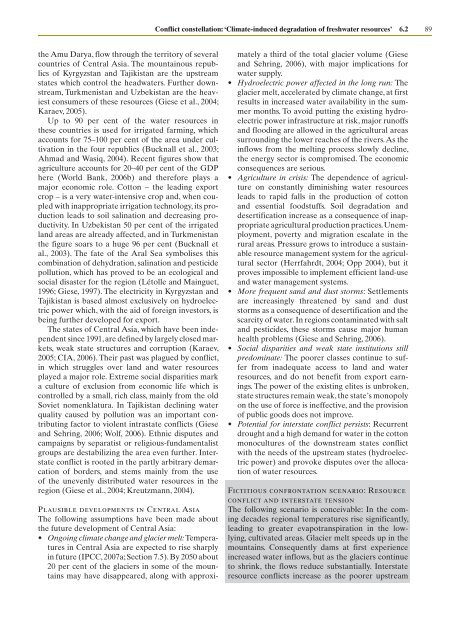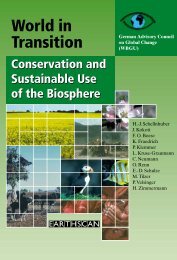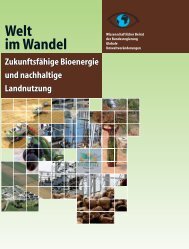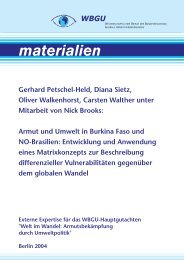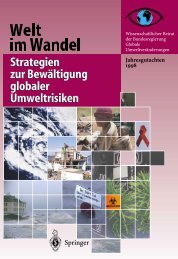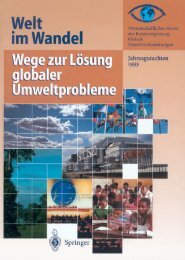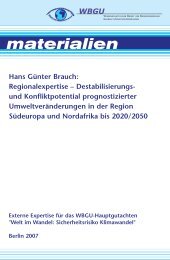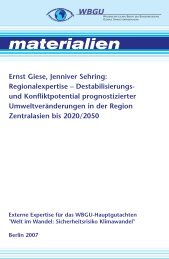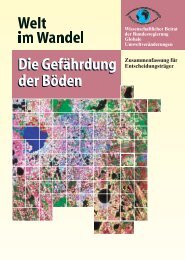World in Transition: Climate Change as a Security Risk - WBGU
World in Transition: Climate Change as a Security Risk - WBGU
World in Transition: Climate Change as a Security Risk - WBGU
Create successful ePaper yourself
Turn your PDF publications into a flip-book with our unique Google optimized e-Paper software.
the Amu Darya, flow through the territory of several<br />
countries of Central Asia. The mounta<strong>in</strong>ous republics<br />
of Kyrgyzstan and Tajikistan are the upstream<br />
states which control the headwaters. Further downstream,<br />
Turkmenistan and Uzbekistan are the heaviest<br />
consumers of these resources (Giese et al., 2004;<br />
Karaev, 2005).<br />
Up to 90 per cent of the water resources <strong>in</strong><br />
these countries is used for irrigated farm<strong>in</strong>g, which<br />
accounts for 75–100 per cent of the area under cultivation<br />
<strong>in</strong> the four republics (Bucknall et al., 2003;<br />
Ahmad and W<strong>as</strong>iq, 2004). Recent figures show that<br />
agriculture accounts for 20–40 per cent of the GDP<br />
here (<strong>World</strong> Bank, 2006b) and therefore plays a<br />
major economic role. Cotton – the lead<strong>in</strong>g export<br />
crop – is a very water-<strong>in</strong>tensive crop and, when coupled<br />
with <strong>in</strong>appropriate irrigation technology, its production<br />
leads to soil sal<strong>in</strong>ation and decre<strong>as</strong><strong>in</strong>g productivity.<br />
In Uzbekistan 50 per cent of the irrigated<br />
land are<strong>as</strong> are already affected, and <strong>in</strong> Turkmenistan<br />
the figure soars to a huge 96 per cent (Bucknall et<br />
al., 2003). The fate of the Aral Sea symbolises this<br />
comb<strong>in</strong>ation of dehydration, sal<strong>in</strong>ation and pesticide<br />
pollution, which h<strong>as</strong> proved to be an ecological and<br />
social dis<strong>as</strong>ter for the region (Létolle and Ma<strong>in</strong>guet,<br />
1996; Giese, 1997). The electricity <strong>in</strong> Kyrgyzstan and<br />
Tajikistan is b<strong>as</strong>ed almost exclusively on hydroelectric<br />
power which, with the aid of foreign <strong>in</strong>vestors, is<br />
be<strong>in</strong>g further developed for export.<br />
The states of Central Asia, which have been <strong>in</strong>dependent<br />
s<strong>in</strong>ce 1991, are def<strong>in</strong>ed by largely closed markets,<br />
weak state structures and corruption (Karaev,<br />
2005; CIA, 2006). Their p<strong>as</strong>t w<strong>as</strong> plagued by conflict,<br />
<strong>in</strong> which struggles over land and water resources<br />
played a major role. Extreme social disparities mark<br />
a culture of exclusion from economic life which is<br />
controlled by a small, rich cl<strong>as</strong>s, ma<strong>in</strong>ly from the old<br />
Soviet nomenklatura. In Tajikistan decl<strong>in</strong><strong>in</strong>g water<br />
quality caused by pollution w<strong>as</strong> an important contribut<strong>in</strong>g<br />
factor to violent <strong>in</strong>tr<strong>as</strong>tate conflicts (Giese<br />
and Sehr<strong>in</strong>g, 2006; Wolf, 2006). Ethnic disputes and<br />
campaigns by separatist or religious-fundamentalist<br />
groups are destabiliz<strong>in</strong>g the area even further. Interstate<br />
conflict is rooted <strong>in</strong> the partly arbitrary demarcation<br />
of borders, and stems ma<strong>in</strong>ly from the use<br />
of the unevenly distributed water resources <strong>in</strong> the<br />
region (Giese et al., 2004; Kreutzmann, 2004).<br />
Plausible developments <strong>in</strong> Central Asia<br />
The follow<strong>in</strong>g <strong>as</strong>sumptions have been made about<br />
the future development of Central Asia:<br />
Ongo<strong>in</strong>g climate change and glacier melt: Temperatures<br />
<strong>in</strong> Central Asia are expected to rise sharply<br />
<strong>in</strong> future (IPCC, 2007a; Section 7.5). By 2050 about<br />
20 per cent of the glaciers <strong>in</strong> some of the mounta<strong>in</strong>s<br />
may have disappeared, along with approxi-<br />
Conflict constellation: ‘<strong>Climate</strong>-<strong>in</strong>duced degradation of freshwater resources’ 6.2<br />
mately a third of the total glacier volume (Giese<br />
and Sehr<strong>in</strong>g, 2006), with major implications for<br />
water supply.<br />
Hydroelectric power affected <strong>in</strong> the long run: The<br />
glacier melt, accelerated by climate change, at first<br />
results <strong>in</strong> <strong>in</strong>cre<strong>as</strong>ed water availability <strong>in</strong> the summer<br />
months. To avoid putt<strong>in</strong>g the exist<strong>in</strong>g hydroelectric<br />
power <strong>in</strong>fr<strong>as</strong>tructure at risk, major runoffs<br />
and flood<strong>in</strong>g are allowed <strong>in</strong> the agricultural are<strong>as</strong><br />
surround<strong>in</strong>g the lower reaches of the rivers. As the<br />
<strong>in</strong>flows from the melt<strong>in</strong>g process slowly decl<strong>in</strong>e,<br />
the energy sector is compromised. The economic<br />
consequences are serious.<br />
Agriculture <strong>in</strong> crisis: The dependence of agriculture<br />
on constantly dim<strong>in</strong>ish<strong>in</strong>g water resources<br />
leads to rapid falls <strong>in</strong> the production of cotton<br />
and essential foodstuffs. Soil degradation and<br />
desertification <strong>in</strong>cre<strong>as</strong>e <strong>as</strong> a consequence of <strong>in</strong>appropriate<br />
agricultural production practices. Unemployment,<br />
poverty and migration escalate <strong>in</strong> the<br />
rural are<strong>as</strong>. Pressure grows to <strong>in</strong>troduce a susta<strong>in</strong>able<br />
resource management system for the agricultural<br />
sector (Herrfahrdt, 2004; Opp 2004), but it<br />
proves impossible to implement efficient land-use<br />
and water management systems.<br />
More frequent sand and dust storms: Settlements<br />
are <strong>in</strong>cre<strong>as</strong><strong>in</strong>gly threatened by sand and dust<br />
storms <strong>as</strong> a consequence of desertification and the<br />
scarcity of water. In regions contam<strong>in</strong>ated with salt<br />
and pesticides, these storms cause major human<br />
health problems (Giese and Sehr<strong>in</strong>g, 2006).<br />
Social disparities and weak state <strong>in</strong>stitutions still<br />
predom<strong>in</strong>ate: The poorer cl<strong>as</strong>ses cont<strong>in</strong>ue to suffer<br />
from <strong>in</strong>adequate access to land and water<br />
resources, and do not benefit from export earn<strong>in</strong>gs.<br />
The power of the exist<strong>in</strong>g elites is unbroken,<br />
state structures rema<strong>in</strong> weak, the state’s monopoly<br />
on the use of force is <strong>in</strong>effective, and the provision<br />
of public goods does not improve.<br />
Potential for <strong>in</strong>terstate conflict persists: Recurrent<br />
drought and a high demand for water <strong>in</strong> the cotton<br />
monocultures of the downstream states conflict<br />
with the needs of the upstream states (hydroelectric<br />
power) and provoke disputes over the allocation<br />
of water resources.<br />
Fictitious confrontation scenario: Resource<br />
conflict and <strong>in</strong>terstate tension<br />
The follow<strong>in</strong>g scenario is conceivable: In the com<strong>in</strong>g<br />
decades regional temperatures rise significantly,<br />
lead<strong>in</strong>g to greater evapotranspiration <strong>in</strong> the lowly<strong>in</strong>g,<br />
cultivated are<strong>as</strong>. Glacier melt speeds up <strong>in</strong> the<br />
mounta<strong>in</strong>s. Consequently dams at first experience<br />
<strong>in</strong>cre<strong>as</strong>ed water <strong>in</strong>flows, but <strong>as</strong> the glaciers cont<strong>in</strong>ue<br />
to shr<strong>in</strong>k, the flows reduce substantially. Interstate<br />
resource conflicts <strong>in</strong>cre<strong>as</strong>e <strong>as</strong> the poorer upstream<br />
89


